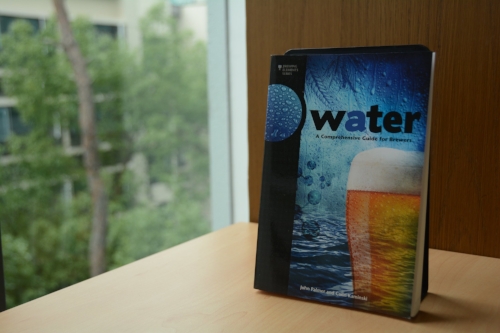5 Books Every Home-brewer Should Own
While there is a plethora of information on homebrewing (and just about everything else) available for free on the internet, including online calculators, discussion forums, and clone recipes, I’m a bit of an old-fashioned student that prefers referencing printed textbooks. To me, I prefer to thumb through the pages of a well-worn brewing book that is peer-reviewed rather than scour the forums for the answers to my questions, often wondering if those well-intentioned responses are trustworthy. I also like to have comprehensive information all bound under one cover rather than consulting six different websites to cover my daily ponderings.
If you’re anything like me then you’ll appreciate having a list of brewing books that have been valuable to me as a homebrewer. In no particular order of importance, here we go:
1. How to Brew - John Palmer
This was the first book that I ever read about brewing, and is probably the text that I have referred back to the most since I started homebrewing. Palmer has cleverly written this to be approachable for brewers of all levels by including a stand-alone chapter to walk you through your first brew, while also offering chapters covering all-extract, extract and specialty grain, and all-grain brewing methods. He’s a former engineer who includes sufficient detail on the science behind the brewing process to satiate the needs of those who must know “why”, but not so much that it excludes the casual brewer. There is a recently-released edition of this text available in print, which I prefer for reference, but he has also shared nearly the entirety of the text online.
2. Designing Great Beers - Ray Daniels
Ray Daniels is most famously known for founding the Cicerone program which continues to grow in popularity across the globe. However, this book is a very useful tool for intermediate-to-advanced brewers who are trying to brew more “to style”. He includes some general information on developing recipes from scratch, including the grain bill, hop schedule, yeast selection and water profile before launching into the topic of brewing classic styles.
Basically, Daniels took beers that made it to at least the second round of the National Homebrew Competition for a selection of style categories and compiled a list of characteristics for each one based on the proven recipes. So as a brewer you can simply look up a style (i.e. hefeweizen) and find an average grain bill (85% of the time the brewer used 50-60% pale wheat malt, for example), as well as average hop schedule (90% used German noble-type hops, for example), and other notes on the water treatment, types of yeast used, and other notes on the brewing process. I love this approach because it gives you a baseline for making your own recipe to attempt a classic style without giving you a blatant clone recipe to follow. As a brewer it’s a great way to practice writing recipes and checking them against more proven recipes. This whole book is an essential tool for understanding the basics of recipe design, so when you’re ready, get yourself a copy for your reference.
3. Mastering the Art of Homebrew - Randy Mosher
Easily the most visually stimulating and appealing book in the list, Mastering Homebrew includes the basics of brewing (much like Palmer’s How to Brew) but presents it with stunning, full-color infographics that help to retain that information for more visual learners. Admittedly, I made some color copies of a selection of the tables, charts, graphs, and graphics and made custom posters for myself to have around my workshop, rather than leaf through the book every time I brew. Particularly, I use a table on sugar additions for natural carbonation/bottle conditioning pretty much every time that I bottle.
In addition to that he has included detailed information on hop characteristics/substitutes, water mineral additions, and the difference between caramelized and roasted malt. With his background in beer tasting and food pairing, Mosher has also included flavor and aroma descriptors for malt and hops, and also suggestions for brewing with certain spices and fruits. It’s an excellent reference book that won’t bore you with black-and-white pages of brewing jargon.
4. The Complete Joy of Homebrewing - Charlie Papazian
This book is oft-quoted by experience homebrewers and even professional brewers as their all-time-favorite book on homebrewing. Papazian has just retired from his role as the head of the American Homebrewers Association and to say that he has left a legacy on the brewers of America would be a gross understatement. This book is also a wonderful reference of the overview of the brewing process, whie also offering a constant reminder not to take ourselves too seriously while brewing. In the immortal words of Papazian, “Relax. Have a homebrew!”
5. Water - John Palmer and Colin Kaminski
The Brewer’s Association published a four-part series on the ingredients of beer: Malt, Hops, Water, and Yeast. While all of them are useful for any brewer’s library, if I had to choose only one of these for the list it would be Water by John Palmer and Colin Kaminski. As a beginning brewer you tend to focus on malt, hops, and yeast without giving any thought to water. However, as you start to get interested in making better beer you quickly realize that you can make marked improvement in your brews by paying attention to your mash schedule and your water profile.
This reference book is not a page-turner by any stretch of the imagination, but it’s also a book about water so that can be expected. The level goes deeper than most homebrewers need to know but the thoroughness can be appreciated. The most helpful sections cover an understanding of the mineral content of the water and its relationship with the mash pH, as well as a quantitative approach to mineral salt additions and their effect on the water profile. As an option, Palmer partnered up with a water testing company called Lamotte to offer a home water-testing kit for brewers. While it doesn’t yield very precise numbers on your existing water profile, it’s easy-to-use and it will give you a general idea of your starting point.
So there’s my top five book recommendations for home-brewers. Of course there are many more that cover much more narrow topics, from brewing ingredients, to brewing history, to brewing traditional styles. I’ve got a nice little library building and as long as I continue brewing I know that I’ll be referencing these books time and time again when a relevant question comes up.
Please post a comment below if you have other recommendations that are in YOUR top five…
— Mr. Jackson








